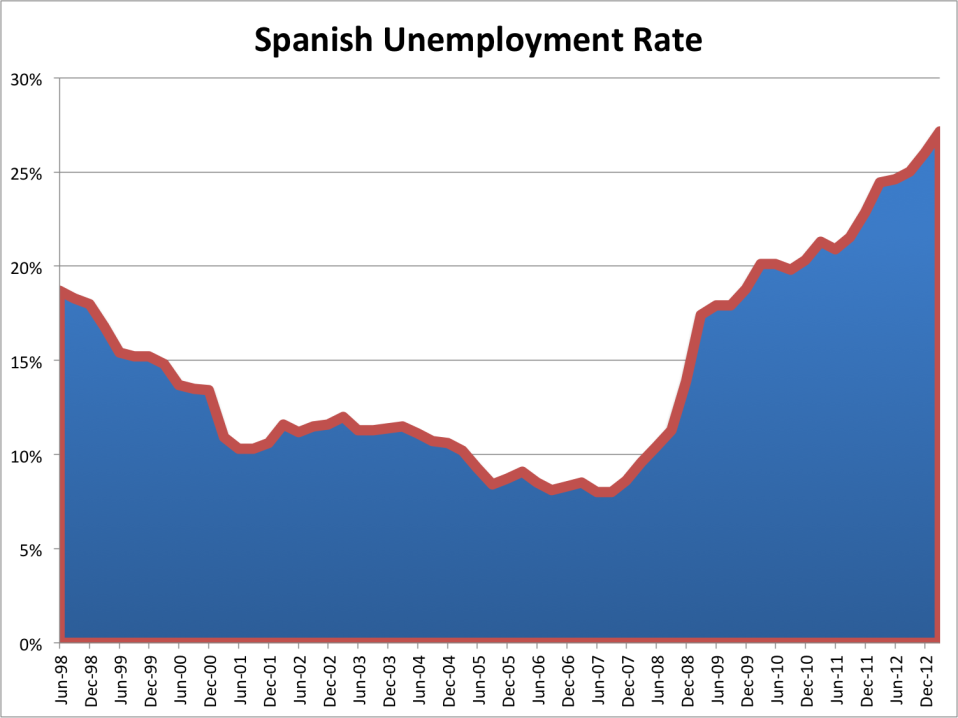The Worst Unemployment Crisis In Modern History Is Unfolding Right Now

REUTERS/Marcelo del Pozo
"Jobless. Help me. Thanks."
At 27.2%, Spain is suffering the worst unemployment rate in modern history.
Spain is tied with Greece, and is worse than the approximately 25% unemployment rate that the U.S. saw during The Great Depression.
The causes, by now, are familiar — the end of a massive, bubble-fueled construction boom in 2008 led to spiraling unemployment and a deep recession, wreaking havoc on the Spanish economy.
And although the country managed to return to marginally positive economic growth in 2010 and 2011, it has since slipped back into recession, and the outlook isn't good.
Unlike the Spanish growth trajectory, the rise in Spanish unemployment since 2008 has been incredibly consistent. Each new statistical release bears the terrible news that more Spaniards have joined the ranks of the unemployed.

Business Insider/Matthew Boesler, data from Bloomberg
The problem is compounded by the fact that Spanish businesses are closing their doors at a record pace. In the first quarter of 2013, 2,564 companies filed for bankruptcy, up 45% from 2012.
And while much attention is paid to the headline unemployment numbers — especially for youths, 57% of whom are now jobless — statistics that give a bit more of a glimpse of how life has changed in Spain since the crisis began are much more revealing.
For most, no job means no income — and in many cases, no income means no food.
According to the Spanish Red Cross' Bulletin on Social Vulnerability, 26% of Spaniards the Red Cross helps can't afford to put a meal with protein on the table even three times a week, and 43% percent can't afford to heat their homes in the winter months.
That is, if they still have their homes — the number of Spaniards facing foreclosures on their mortgages and evictions is rising fast.
Foreclosures ordered by courts in 2012 alone totaled 91,622, up 17.7% from 2011.
Some of these cases have ended in suicide. In November, a woman jumped six stories to her death as foreclosure agents were forcing open her front door. In February, an elderly married couple took their own lives, citing impending foreclosure in a note.
In January, there were even two cases of men who set themselves on fire.
At least one of them was reported to have lost his job and was facing financial issues.
This is the environment from which those in Spain are actively attempting to escape.
During the good years, Spain experienced a swelling population as immigrants came to fill the excess of employment opportunities caused by the Spanish construction boom.
Now, they are leaving. In 2012, Spain saw its population actually decrease for the first time since records began being kept in the 1990s.
However, the population outflow isn't just former immigrants turning into emigrants. Young Spaniards, faced with no opportunities at home, are packing up everything they own and fleeing to countries like Canada in search of opportunity.
Is there hope? The IMF's latest World Economic Outlook paints a grim picture. The international lender forecasts a 1.6% contraction in 2013, and doesn't see Spain returning to even 1.5% GDP growth until 2017.
And while the Spanish Labor Ministry today reported a drop in unemployment in April — down 0.9% to 4.99 million officially-registered job-seekers — analysts were quick to write this off as a temporary respite due to increased hiring for the holiday season.
More From Business Insider

